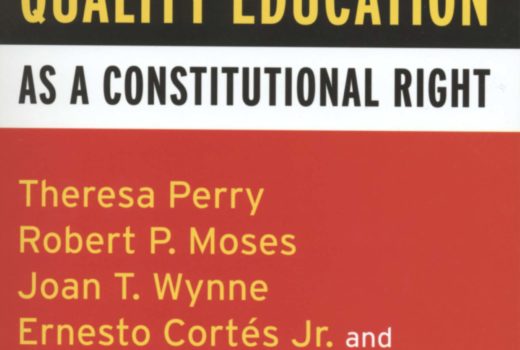 Quality Education as a Constitutional Right: Creating a Grassroots Movement to Transform Public Schools; Theresa Perry, Robert Moses, Lisa Delpit, Ernesto Cortes Jr., Joan T. Wynne, editors; Beacon Press Books; 2010; Paperback $16
Quality Education as a Constitutional Right: Creating a Grassroots Movement to Transform Public Schools; Theresa Perry, Robert Moses, Lisa Delpit, Ernesto Cortes Jr., Joan T. Wynne, editors; Beacon Press Books; 2010; Paperback $16
Quality Education as a Constitutional Right offers a provocative look at the continued disconnect between the rhetoric of reform and the facts of the real world. Statistics are in short supply here. Instead, we hear the heartfelt voices of reformers and advocates as well as of young people in underserved communities.
Chief among the former group is Robert P. Moses, a co-author of the book and the person most responsible for its creation. Moses, a 1956 graduate of Hamilton College, became deeply involved in the Civil Rights Movement during the 1960s through organizations such as the Student Nonviolent Coordinating Committee and the Council of Federated Organizations. He was a primary organizer of the Freedom Summer project, which worked to enfranchise black citizens in Mississippi. Later, he worked as a teacher in Tanzania, returning to the U.S. to pursue graduate studies at Harvard in 1976, after which he taught high school math in Cambridge, Mass.
In 1982, he combined some of his career threads in the Algebra Project, which he funded from the proceeds of a MacArthur Fellowship. The project, an ongoing effort, focuses on improving minority math education.
Fast forward to 2005, when Moses organized a gathering of African-American and Latino activists and intellectuals to envision the establishment of a movement to campaign for “quality education for all children as a constitutional right.” While arguably a somewhat quixotic notion, given the political realities of our times, Moses and his followers have continued to seed the nation with this provocative concept, notably though not exclusively through this volume.
Perhaps necessarily, though its title might imply otherwise, this book is not a detailed plan of action. Instead, it is our seat at the table, as it were, at the 2005 conference: an opportunity to share the thinking and tap into the feelings of people who are most connected to an ongoing national tragedy. The contents of the book came either directly from the 2005 event or were inspired by it. For instance, Ernesto Cortés, director of the Southwest Regional Industrial Areas Foundation, and a participant in the 2005 event, offers perspectives on the challenges ahead based on his work with Latino communities in Texas. For the reader, this is both the strength and the weakness of the book. We must reach our own conclusions but we have ample opportunity to learn or be reminded of inequity and its awful persistence as well as the long, noble tradition of resistance to injustice.
In an introductory essay, Linda Mizell, an assistant professor of education at the University of Colorado, Boulder, takes issue with the culturally persistent myth that blacks don’t care about education, pointing out that literacy and education were always seen as escape routes from slavery, oppression and poverty. Indeed, efforts by African-Americans to achieve literacy, let alone further education, were frequently viewed as subversive and dangerous within the majority culture, even in the recent historical past. She cites the story of a slave who was blinded by an overseer for trying to learn how to read. In a current-day context, we have the voice of Kimberly Parker, with her essay describing her upbringing and the forces (including her experiences as an undergraduate at Colby College and pursuing a master’s degree at Boston College) that led her to a career in teaching. And, beyond that simple act of career choice, we experience her commitment to change the lives of the students she later encounters at the Codman Academy Charter School in Boston through more forms of creative subversion. Other stories in the book remind us of the power of education and of literacy and of the terrible struggles so many went through to secure even the most basic elements of education.
To move from those frightening lessons to the present era, we are introduced to Baltimore public school students who engaged in protests and direct action a few years ago to try to secure state funding for their bankrupt school systems. We are reminded that this isn’t simply a faddish political activity adopted passingly but rather part of a long-term effort at survival and empowerment—with living links (Moses is one) to a long history of wrongs suffered and rights granted grudgingly. And inferior educational opportunity has been one of the greatest wrongs.
Here, Quality Education as a Constitutional Right does manage to provide some solid examples of successful efforts to bridge the gap and deliver meaningful educational opportunities to underserved groups. In the case of Moses’s Algebra Project, we learn about the way this program has been implemented in a number of communities and the specific elements that have helped it resonate and communicate with students and parents alike.
Likewise, the essay by Joanne T. Wynne and Janice Giles provides insights into some of the ways in which university collaborations can benefit efforts like the Algebra Project.
Putting the right to an education into the Constitution may not really be the goal of this book or its authors, but by “creating a grassroots movement to transform public schools” they may help to achieve just as much as would that ambitious goal. The lessons are fresh and compelling and the examples inspired.
Reviewed by Alan R. Earls, a Boston-area writer.
[ssba]
